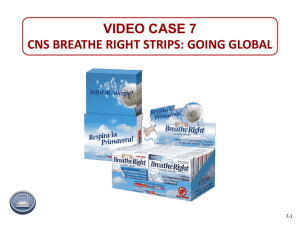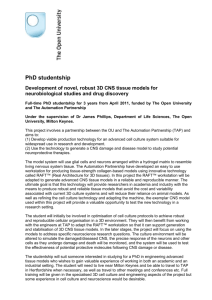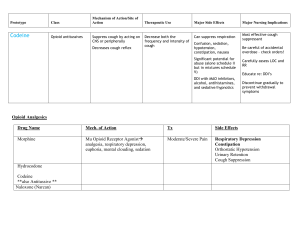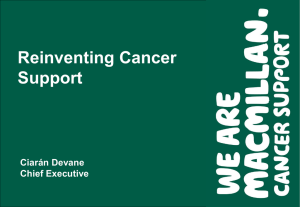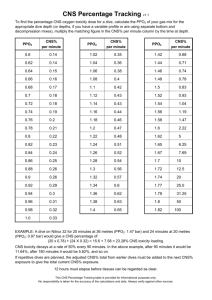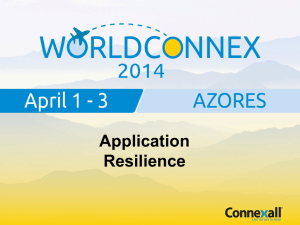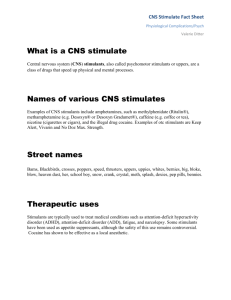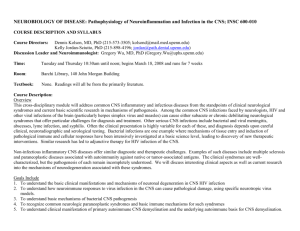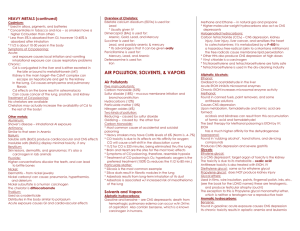week 1
advertisement
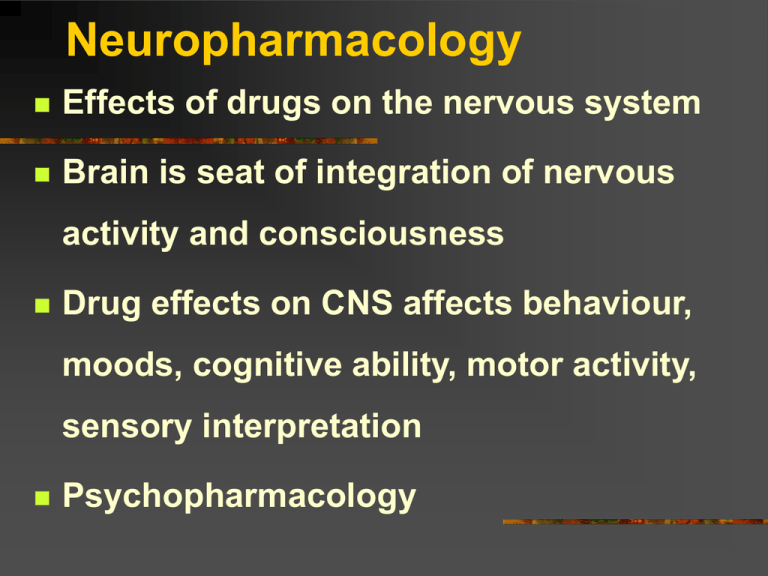
Neuropharmacology Effects of drugs on the nervous system Brain is seat of integration of nervous activity and consciousness Drug effects on CNS affects behaviour, moods, cognitive ability, motor activity, sensory interpretation Psychopharmacology The Grand Scheme CNS Structure and Function Methods of research in Behavioural Psychopharmacology Neurotransmitters and the CNS Neurodegenerative disorders And then…………. Drug dependance and addiction Alcohol, CNS stimulators, cannabinoids, opiates Anaesthetics Affective disorders Anxiety disorders Schizophrenia Psychoactive drugs Found throughout recorded history Opium poppy Alcohol Ancient Mesopotamia – laws to control drinking Peyote cactus (mescaline) Neolithic burial sites Native Americans Amanita mushroom Vikings Curative or Medicinal Effects Coca leaves (cocaine) S.American silver mines – increase mental and physical vigilance in low PO2 environment Tea (caffeine) General tonic for the sages of Ancient China Indian snake root (rauwolfia serpenina) Treatment for manic excitement, hallucinations, delusion Reserpine – depletes dopamine stores Psychoactive Drugs: 1000s of drugs – only a few main CLASSES Common Mechanisms CNS stimulants: eg amphetamine (amine), cocaine (alkaloid) Alertness , faster behavioural responses Stimulate release of dopamine, inhibits its inactivation Most CNS stimulants boost dopamine and/or adrenaline CNS depressants Eg alcohol, barbiturates Feelings of sleepiness, impaired psychomotor functions CNS depressants affect the GABA ( amino butyric acid) receptor GABA-ergic drugs inhibit neuronal activity Drugs +ve and –ve effects Alcohol (aggression, antisocial behaviour, criminal behaviour) Cocaine (aggression, suspicion) Antidepressants (drowsiness, dry mouth) Antipsychotics (drowsiness, dry mouth etc) Tolerance (adaptive change in CNS) Dependance (no benefit; only satisfy craving etc) Divisions of the Nervous System Rest and digestion Fight and flight Sensory afferent neurons Sensory (afferent: “towards”) Chemoreceptors Mechanoreceptors Nociceptors Photoreceptors Thermoreceptors Polysynaptic Reflex Effectors: Conscious or unconscious PROCESSING Muscles Glands Reaction Times vary with complexity of task 1ms delay for each synapse Time between input and output increase with the number of synapses Monosynaptic “knee jerk” takes around 30ms Reaction time task: 200ms Choice reaction time task: >450ms Reaction time Information processing Sensitive to drug effects CNS stimulants reduce reaction time CNS depressant drugs retard reaction time The Brain (Cerebral cortex) Cerebrospinal Fluid (CSF) CSF-filled subarachnoid space Typical vs Brain Capillaries Blood Brain Barrier –selectively permeable (not impermeable) Typical capillaries Brain capillaries Intercellular clefts IC clefts closed Fenestrations (tight junctions) Pinocytotic vesicles Fenestrations absent Pinocytotic vesicles rare “Glial feet” extensions of astrocytes surround capillaries Blood-Brain barrier not complete Area Postrema (or CTZ – chemical trigger zone) Medulla of brain stem “vomiting centre” Median eminence of the hypothalamus Hypothalamic neurotransmitters anterior pituitary Limited permeability and drug action Physostigmine readily crosses barrier Useful for treating intoxication from pesticides Increases availability of acetylcholine Neostigmine is excluded from brain increases Ach only peripherally Neostigmine can treat myasthenia gravis without CNS side effects, but not pesticide induced intoxication Regions of the Brain Telencephalon Cerebral cortex Limbic system Moods, emotions, learning,memory Basal ganglia Voluntary movement The Limbic System Basal Ganglia: dopamine (corpus striatum) (mesencephalon) Metencephalon and myelencephalon (medulla) of hind brain Cerebellum Pons/medulla = brainstem Vasomotor, cardiac centre, respiratory centre, vomiting, cough Brainstem death (o.d. CNS depressants) Ascending Reticular Activating System ARAS – fibre bundle runs through core of brainstem into thalamus Maintains arousal Sedative-hypnotic drugs reduce basic ARAS activity – sleepiness Antipsychotic drugs (eg chlorpromazine) reduce sensory and cortical input to ARAS Person awake, but less arousable; either by environmental events or their own thoughts/feelings Neurones 100 trillion (1012) Each neuron connects to 1000 – 10000 others 1g cortex = 109 synapses Lost at 20000 per day The Neurone Soma (cell body Dendrites (and dendritic spines) Receive signals from other cells via a gap called the synapse Axons Single tubular extension conducts electrical signal to terminal boutons Formation of Myelin Sheath CNS Axonal Transport KINESIN DYNEIN Action Potential “All or Nothing” The Neural Code Discharge frequency dependant upon stimulus intensity Action potential must be “re-set” before another can be triggered Refractory period The Resting Potential Differential permeability Electrostatic gradient -70mV (inside vs outside) Saltatory Conduction Summation of IPSP/EPSP presynaptic THE SYNAPSE postsynaptic

